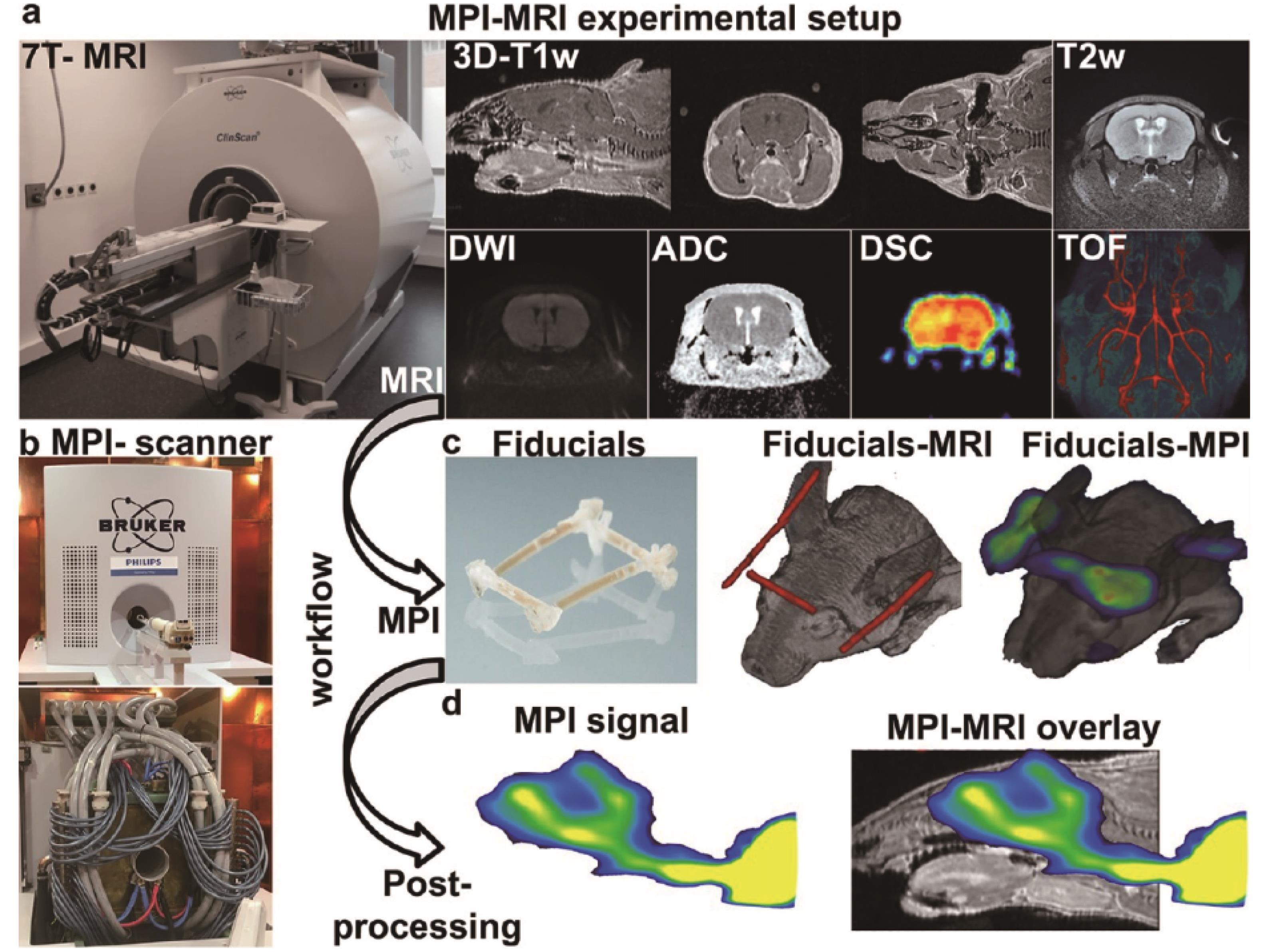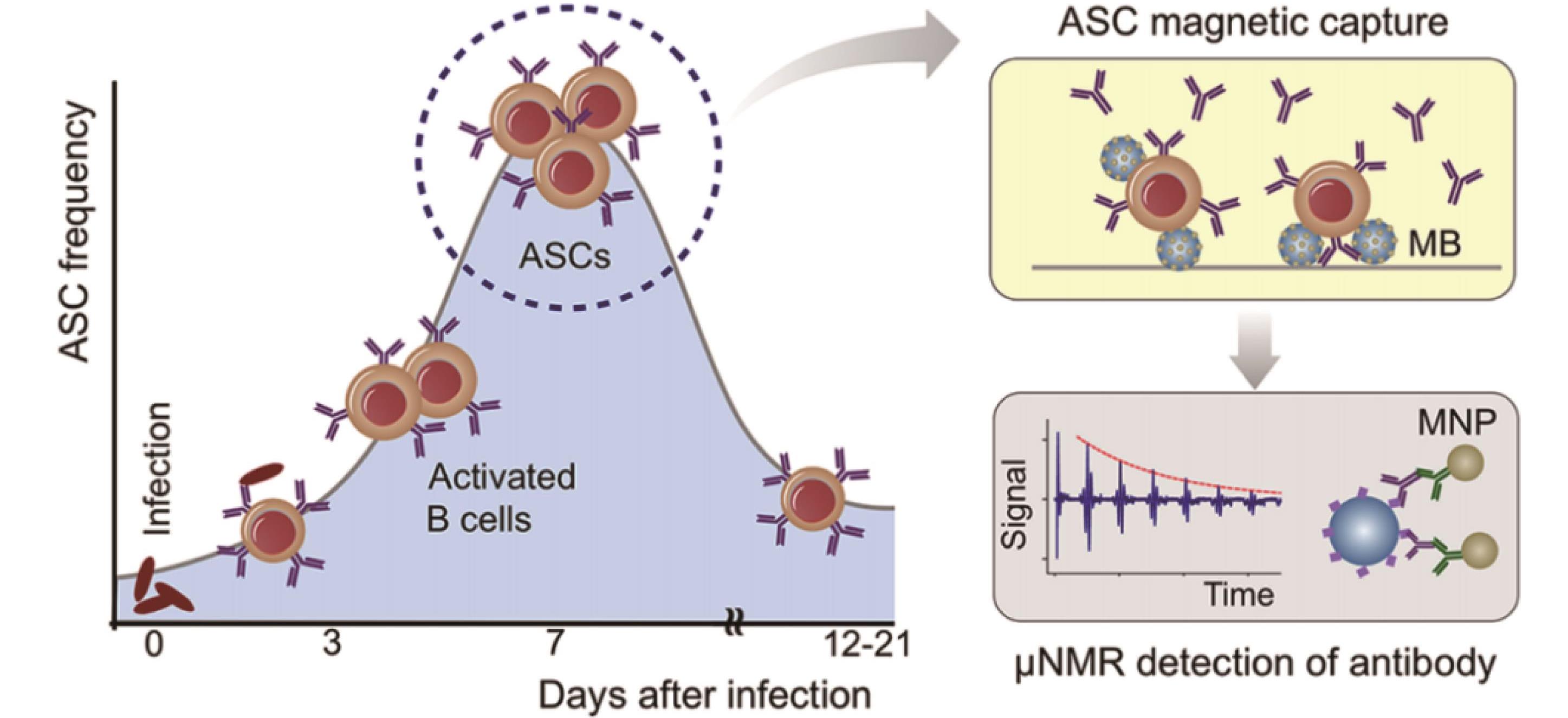
应用化学 ›› 2022, Vol. 39 ›› Issue (3): 391-406.DOI: 10.19894/j.issn.1000-0518.210394
过渡金属掺杂磁性纳米粒子在生物医学领域中的研究进展
杜慧1,3, 姚晨阳1,3, 彭皓1,3, 姜波1, 李顺祥1, 姚俊烈1, 郑方1, 杨方1,2( ), 吴爱国1,2(
), 吴爱国1,2( )
)
- 1.中国科学院宁波材料科学技术与工程研究所 慈溪生物医学工程研究所,浙江省生物医学材料技术与应用国际 科技合作基地,中国科学院磁性材料与器件重点实验室,医用植介入材料浙江省工程研究中心,宁波 315201
2.先进能源科学与技术广东省实验室,惠州 516000
3.中国科学院大学,北京 100049
-
收稿日期:2021-08-07接受日期:2021-11-03出版日期:2022-03-01发布日期:2022-03-15 -
通讯作者:杨方,吴爱国 -
基金资助:国家自然科学基金(32025021);国家科技部(2018YFC0910601);浙江省科技厅(2020C03110);宁波市科技局(2020Z094)
Applications of Transition Metal⁃doped Iron⁃based Nanoparticles in Biomedicine
Hui DU1,3, Chen-Yang YAO1,3, Hao PENG1,3, Bo JIANG1, Shun-Xiang LI1, Jun-Lie YAO1, Fang ZHENG1, Fang YANG1,2( ), Ai-Guo WU1,2(
), Ai-Guo WU1,2( )
)
- 1.Zhejiang Biomedical Materials Technology and Application International Science and Technology Cooperation Base,Key Laboratory of Magnetic Materials and Devices,Zhejiang Engineering Research Center for ImplantInterventional Materials,Cixi Institute of Biomedical Engineering,Ningbo Institute of Materials Technologyand Engineering,Chinese Academy of Sciences,Ningbo 315201,China
2.Guangdong Laboratory of Advanced Energy Science and Technology,Huizhou 516000,China
3.University of Chinese Academy of Sciences,Beijing 100049,China
-
Received:2021-08-07Accepted:2021-11-03Published:2022-03-01Online:2022-03-15 -
Contact:Fang YANG,Ai-Guo WU -
About author:yangf@nimte.ac.cn; aiguo@nimte.ac.cn
-
Supported by:the National Natural Science Foundation of China(32025021);the Ministry of Science and Technology of China(2018YFC0910601);the Department of Science and Technology of Zhejiang Province(2020C03110);the Science and Technology Bureau of Ningbo Municipality(2020Z094)
摘要:
在过去50多年中,磁性纳米粒子(MNPs)由于其可协调的磁性、非侵入性、易操控性和良好的生物相容性等优点得到了广泛的关注。从具有复合结构或不同形状的MNPs的合成方法到与MNPs相关的大量表征技术,其应用领域也与我们的生活紧密相关。 然而,MNPs的复杂磁行为受到多种参量的影响,包括粒径、成分、形状和结构等。基于此,通过调节MNPs的主要参量提高其磁功能效果对后续的材料设计和应用具有重大的参考意义。其中,二价过渡金属离子的掺杂是影响MNPs各种磁性能(如磁矩(μ)、饱和磁化强度(Ms)、矫顽力(Hc)、磁晶各向异性(K)和弛豫时间(τN和τB)等)重要参量之一。因此,本文着重介绍了通过向磁性纳米材料中掺杂过渡金属离子来精确调控其磁性的相关机理研究,并介绍了掺杂过渡金属离子的MNPs在生物成像检测(磁共振成像和磁性粒子成像)、药物精准递送和肿瘤治疗以及生物传感方面的潜在机制和所取得的最新进展,最后总结了目前MNPs所面临的一些挑战以及未来发展的趋势。
中图分类号:
引用本文
杜慧, 姚晨阳, 彭皓, 姜波, 李顺祥, 姚俊烈, 郑方, 杨方, 吴爱国. 过渡金属掺杂磁性纳米粒子在生物医学领域中的研究进展[J]. 应用化学, 2022, 39(3): 391-406.
Hui DU, Chen-Yang YAO, Hao PENG, Bo JIANG, Shun-Xiang LI, Jun-Lie YAO, Fang ZHENG, Fang YANG, Ai-Guo WU. Applications of Transition Metal⁃doped Iron⁃based Nanoparticles in Biomedicine[J]. Chinese Journal of Applied Chemistry, 2022, 39(3): 391-406.
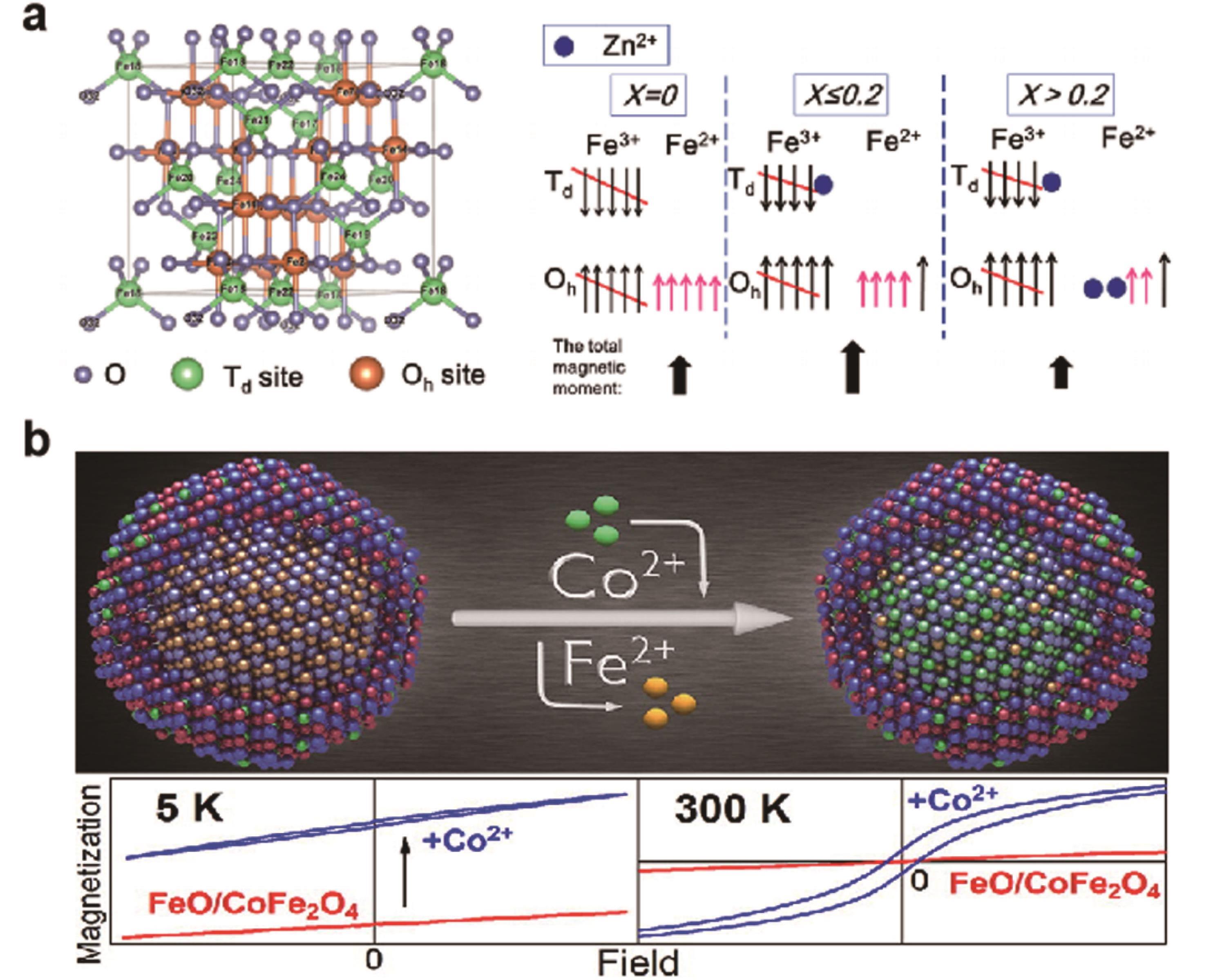
图2 (a)在油酸/酒精/水系统下不同锌掺杂量的铁氧体的掺杂机理及其总磁矩的变化情况[8]; (b)以离子交换的形式向铁氧体中掺杂Co2+对其矫顽力的影响[9]
Fig.2 (a) Doping mechanism of ferrite with different zinc doping and its total magnetic moment in oleic acid/alcohol/water system[8]. (b) Effect of Co2+ doping into ferrite in the form of ion exchange on its coercivity[9]
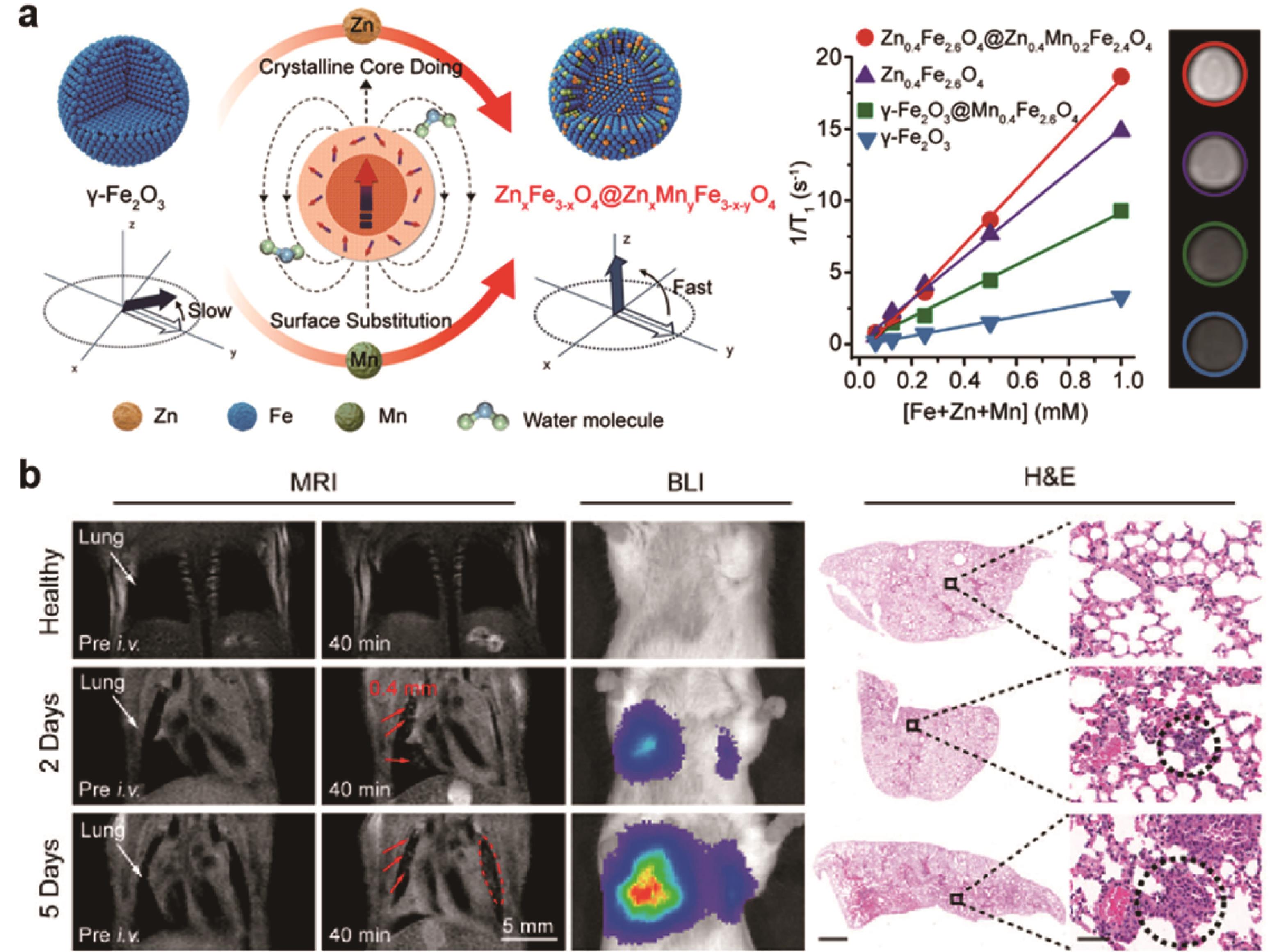
图3 (a)向γ-Fe2O3中掺杂Zn2+和Mn2+的机理图以及所合成的MNPs的T1加权成像效果[14]; (b)静脉注射Zn0.4F@Zn0.4Mn0.2 F-AMD 40 min后小鼠转移的T1加权图像、生物发光成像(BLI)和肺部组织切片图像(H&E)[14]
Fig.3 (a) Mechanistic diagram of doping Zn2+ and Mn2+ into γ-Fe2O3 and the T1-weighted imaging effect of the synthesized MNPs[14]. (b) MRI T1-weighted images of metastases in mice of Zn0.4F@Zn0.4Mn0.2F-AMD, BLI images and H&E images of the lung (scale bar: left, 1 mm; right, 50 μm)[14]
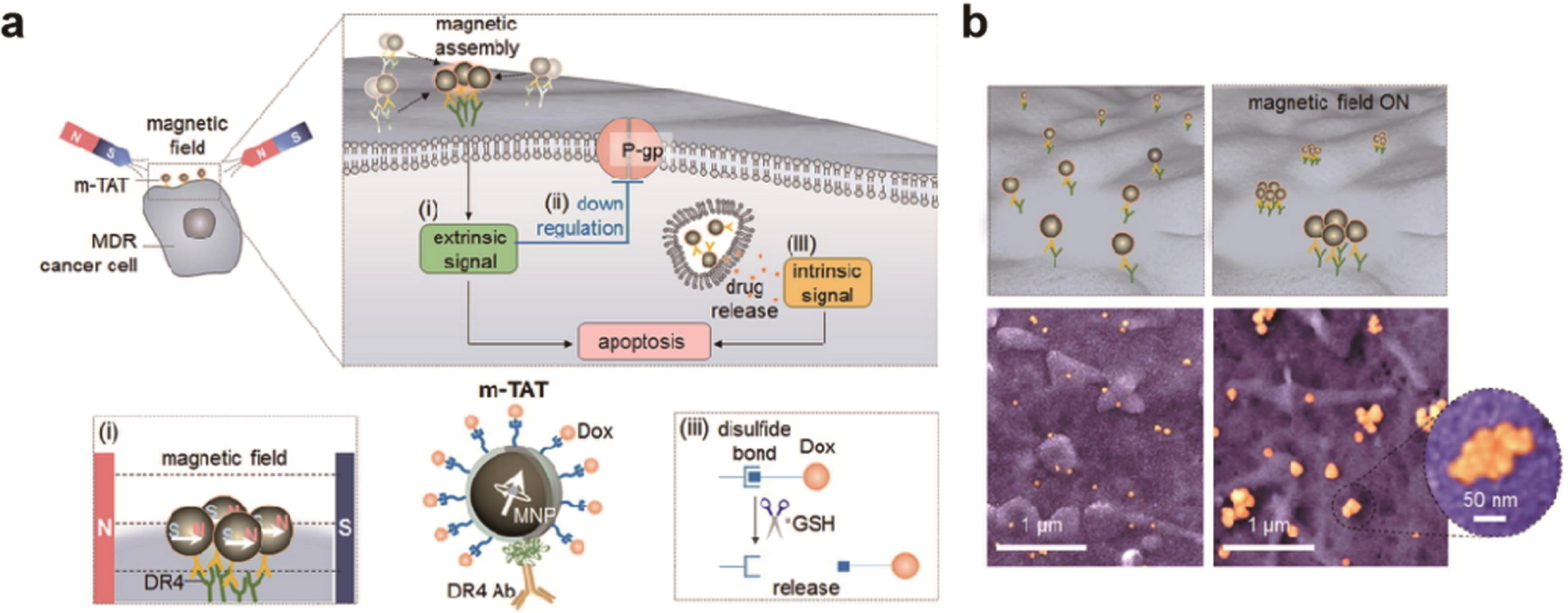
图5 (a)基于磁性纳米颗粒激活细胞凋亡信号的聚集策略:磁性开关聚集死亡受体4(DR4),通过TRAIL模拟生化信号,用于诱导细胞凋亡;(b)在细胞表面拍摄到的M-TAT的扫描电子显微镜(SEM)图像[37]
Fig.5 (a) Aggregation strategy based on magnetic nanoparticles to activate apoptotic signaling: magnetic switch aggregates death receptor 4 (DR4), which is used to induce apoptosis by TRAIL mimicking biochemical signaling[37]; (b) Scanning electron microscopy (SEM) images of M-TAT on the surface of cells[37]
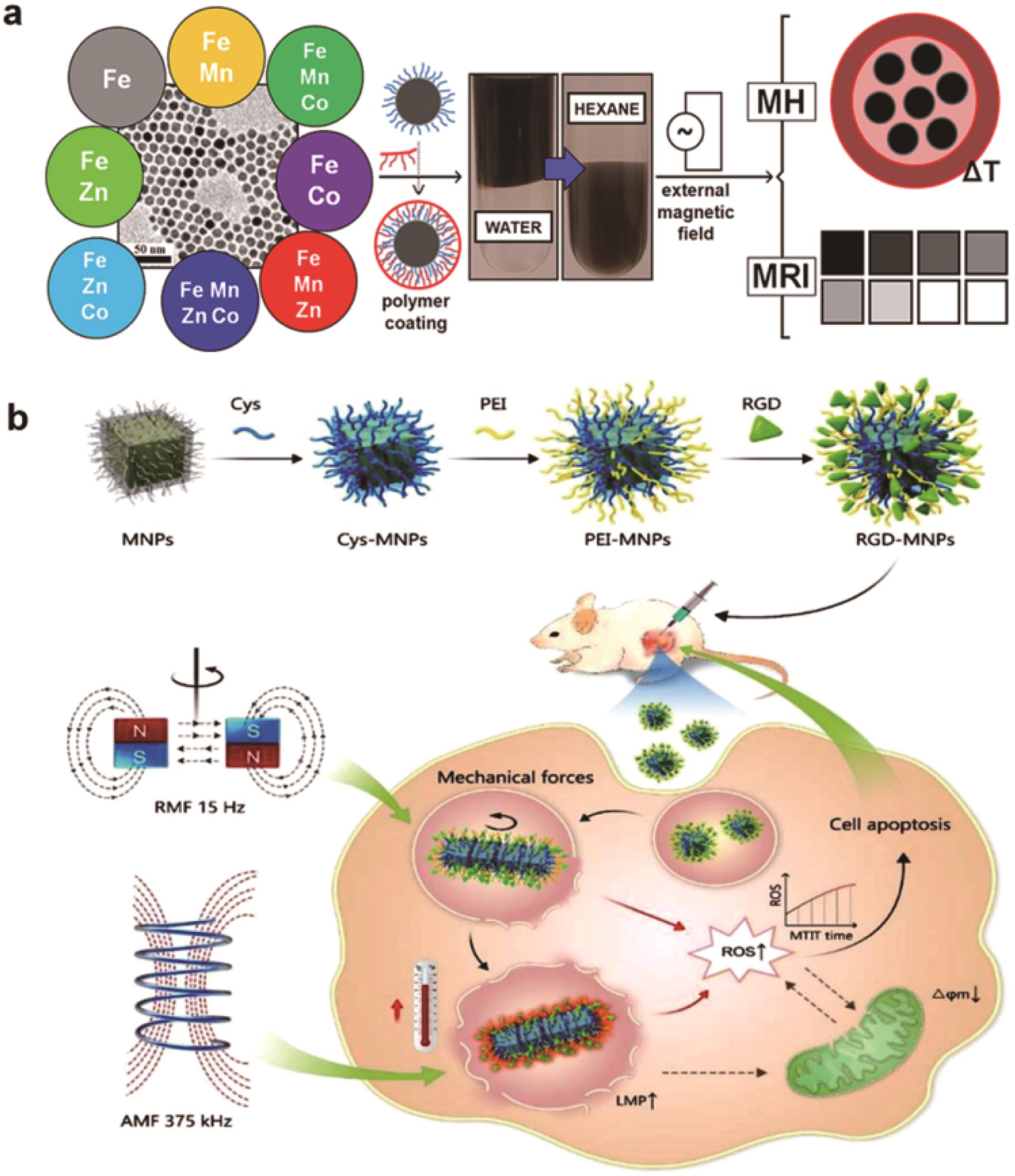
图6 (a)多组分(Mn、Zn、Co)掺杂铁氧体用于磁热研究[49]; (b)基于自旋磁场组装的磁致机械力和高频交变磁场触发的磁热协同疗法(MTIT) [51]
Fig.6 (a) Multicomponent (Mn, Zn, Co) doped ferrite for magnetothermal studies[49]; (b) Magneto-mechanical force based on spin- field assembly and high frequency alternating magnetic field triggered magnetothermal synergy therapy (MTIT)[51]
| 1 | HU Y, MIGNANI S, MAJORAL J P, et al. Construction of iron oxide nanoparticle-based hybrid platforms for tumor imaging and therapy[J]. Chem Soc Rev, 2018, 47(5): 1874-1900. |
| 2 | POON W, KINGSTON B R, OUYANG B, et al. A framework for designing delivery systems[J]. Nat Nanotechnol, 2020, 15(10): 819-829. |
| 3 | WANG J, LI Y, NIE G. Multifunctional biomolecule nanostructures for cancer therapy[J]. Nat Rev Mater, 2021: 1-18. |
| 4 | WILLIAMS A R, MORUZZI V L, GELATT C D, et al. Aspects of transition-metal magnetism[J]. J Appl Phy, 1982, 53(3): 2019-2023. |
| 5 | JANG J T, NAH H, LEE J H, et al. Critical enhancements of MRI contrast and hyperthermic effects by dopant-controlled magnetic nanoparticles[J]. Angew Chem Int Ed Engl, 2009, 48(7): 1234-1242. |
| 6 | LIU C, ZOtU B, RONDINONE A J, et al. Chemical Control of superparamagnetic properties of magnesium and cobalt spinel ferrie nanoparticles through atomic level magnetic couplings[J]. J Am Chem Soc, 2000, 122(26): 6263-6267. |
| 7 | LEE J H, HUH Y M, JUN Y W, et al. Artificially engineered magnetic nanoparticles for ultra-sensitive molecular imaging[J]. Nat Med, 2007, 13(1): 95-99. |
| 8 | FRAGA C G. Relevance, essentiality and toxicity of trace elements in human health[J]. Mol Asp Med, 2005, 26(4/5): 235-244. |
| 9 | LANDSIEDEL R, MA-HOCK L, KROLL A, et al. Testing metal-oxide nanomaterials for human safety[J]. Adv Mater, 2010, 22(24): 2601-2627. |
| 10 | MA Y, XIA J, YAO C, et al. Precisely tuning the contrast properties of ZnxFe3– xO4 nanoparticles in magnetic resonance imaging by controlling their doping content and size[J]. Chem Mater, 2019, 31(18): 7255-7264. |
| 11 | SYTNYK M, KIRCHSCHLAGER R, BODNARCHUK M I, et al. Tuning the magnetic properties of metal oxide nanocrystal heterostructures by cation exchange[J]. Nano Lett, 2013, 13(2): 586-593. |
| 12 | GABAL M A, BAYOUMY W A. Effect of composition on structural and magnetic properties of nanocrystalline Ni0.8- xZn0.2MgxFe2O4 ferrite[J]. Polyhedron, 2010, 29(13): 2569-2573. |
| 13 | ZHOU Z, YANG L, GAO J, et al. Structure-relaxivity relationships of magnetic nanoparticles for magnetic resonance imaging[J]. Adv Mater, 2019, 31(8): e1804567. |
| 14 | MIAO Y, ZHANG H, CAI J, et al. Structure-relaxivity mechanism of an ultrasmall ferrite nanoparticle T1 MR contrast agent: the impact of dopants controlled crystalline core and surface disordered shell[J]. Nano Lett, 2021, 21(2): 1115-1123. |
| 15 | CHOI J S, KIM S, YOO D, et al. Distance-dependent magnetic resonance tuning as a versatile MRI sensing platform for biological targets[J]. Nat Mater, 2017, 16(5): 537-542. |
| 16 | SHIN T H, KANG S, PARK S, et al. A magnetic resonance tuning sensor for the MRI detection of biological targets[J]. Nat Protoc, 2018, 13(11): 2664-2684. |
| 17 | GLEICH B, WEIZENECKER R. Tomographic imaging using the nonlinear response of magnetic particles[J]. Nature, 2005, 435(7046): 1214-1217. |
| 18 | GOODWILL P W, SARITAS E U, CROFT L R, et al. X-space MPI: magnetic nanoparticles for safe medical imaging[J]. Adv Mater, 2012, 24(28): 3870-3877. |
| 19 | LEMASTER J E, CHEN F, KIM T, et al. Development of a trimodal contrast agent for acoustic and magnetic particle imaging of stem cells[J]. ACS Appl Nano Mater, 2018, 1(3): 1321-1331. |
| 20 | WU L, MENDOZA-GARCIA A, LI Q, et al. Organic phase syntheses of magnetic nanoparticles and their applications[J]. Chem Rev, 2016, 116(18): 10473-10512. |
| 21 | SONG G, KENNEY M, CHEN Y S, et al. Carbon-coated FeCo nanoparticles as sensitive magnetic-particle-imaging tracers with photothermal and magnetothermal properties[J]. Nat Biomed Eng, 2020, 4(3): 325-334. |
| 22 | ARAMI H, TEEMAN E, TROKSA A, et al. Tomographic magnetic particle imaging of cancer targeted nanoparticles[J]. Nanoscale, 2017, 9(47): 18723-18730. |
| 23 | LUDEWIG P, GDANIEC N, SEDLACIK J, et al. Magnetic particle imaging for real-time perfusion imaging in acute stroke[J]. ACS Nano, 2017, 11(10): 10480-10488. |
| 24 | SONG G, CHEN M, ZHANG Y, et al. Janus iron oxides@semiconducting polymer nanoparticle tracer for cell tracking by magnetic particle imaging[J]. Nano Lett, 2018, 18(1): 182-189. |
| 25 | BAUER L M, SITU S F, GRISWOLD M A, et al. High-performance iron oxide nanoparticles for magnetic particle imaging - guided hyperthermia (hMPI)[J]. Nanoscale, 2016, 8(24): 12162-12169. |
| 26 | JIANG Z, HAN X, DU Y, et al. Mixed metal metal-organic frameworks derived carbon supporting ZnFe2O4/C for high-performance magnetic particle imaging[J]. Nano Lett, 2021, 21(7): 2730-2737. |
| 27 | DU Y, LIU X, LIANG Q, et al. Optimization and design of magnetic ferrite nanoparticles with uniform tumor distribution for highly sensitive MRI/MPI performance and improved magnetic hyperthermia therapy[J]. Nano Lett, 2019, 19(6): 3618-3626. |
| 28 | MÜLLER D J, HELENIUS J, ALSTEENS D, et al. Force probing surfaces of living cells to molecular resolution[J]. Nat Chem Biol, 2009, 5(6): 383-390. |
| 29 | CHENG Y, MUROSKI M E, PETIT D, et al. Rotating magnetic field induced oscillation of magnetic particles for in vivo mechanical destruction of malignant glioma[J]. J Control Release, 2016, 223: 75-84. |
| 30 | XIA Y, SUN J, ZHAO L, et al. Magnetic field and nano-scaffolds with stem cells to enhance bone regeneration[J]. Biomaterials, 2018, 183: 151-170. |
| 31 | GAHL T J, KUNZE A. Force-mediating magnetic nanoparticles to engineer neuronal cell function[J]. Front Neurosci, 2018, 12: 299. |
| 32 | WU C, SHEN Y, CHEN M, et al. Recent advances in magnetic-nanomaterial-based mechanotransduction for cell fate regulation[J]. Adv Mater, 2018, 30(17): e1705673. |
| 33 | LIU H, WEN J, XIAO Y, et al. In situ mechanical characterization of the cell nucleus by atomic force microscopy[J]. ACS Nano, 2014, 8(4): 3821-3829. |
| 34 | YUN H M, AHN S J, PARK K R, et al. Magnetic nanocomposite scaffolds combined with static magnetic field in the stimulation of osteoblastic differentiation and bone formation[J]. Biomaterials, 2016, 85: 88-98. |
| 35 | CHENYANG Y, FANG Y, LI S, et al. Magnetically switchable mechano-chemotherapy for enhancing the death of tumour cells by overcoming drug-resistance[J]. Nano Today, 2020, 35: 100967. |
| 36 | YUAN Y, DING Z, QIAN J, et al. Casp3/7-instructed intracellular aggregation of Fe3O4 nanoparticles enhances T2 MR imaging of tumor apoptosis[J]. Nano Lett, 2016, 16(4): 2686-2691. |
| 37 | CHO M H, KIM S, LEE J H, et al. Magnetic tandem apoptosis for overcoming multidrug-resistant cancer[J]. Nano Lett, 2016, 16(12): 7455-7460. |
| 38 | ZHANG E, KIRCHER M F, KOCH M, et al. Dynamic magnetic fields remote-control apoptosis via nanoparticle rotation[J]. ACS Nano, 2014, 8(4): 3192-3201. |
| 39 | DOMENECH M, MARRERO-BERRIO I, TORRES-LUGO M, et al. Lysosomal membrane permeabilization by targeted magnetic nanoparticles in alternating magnetic fields[J]. ACS Nano, 2013, 7(6): 5091. |
| 40 | CHEN M, WU J, NING P, et al. Remote control of mechanical forces via mitochondrial-targeted magnetic nanospinners for efficient cancer treatment[J]. Small, 2020, 16(3): e1905424. |
| 41 | BRAY F, FERLAY J, SOERJOMATARAM I, et al. Global cancer statistics 2018: GLOBOCAN estimates of incidence and mortality worldwide for 36 cancers in 185 countries[J]. CA Cancer J Clin, 2018, 68(6): 394-424. |
| 42 | NOH S H, MOON S H, SHIN T H, et al. Recent advances of magneto-thermal capabilities of nanoparticles: from design principles to biomedical applications[J]. Nano Today, 2017, 13: 61-76. |
| 43 | MARMUGI L, RENZONI F. Optical magnetic induction tomography of the heart[J]. Sci Rep, 2016, 6: 23962. |
| 44 | LEE N, YOO D, LING D, et al. Iron oxide based nanoparticles for multimodal imaging and magnetoresponsive therapy[J]. Chem Rev, 2015, 115(19): 10637-10689. |
| 45 | LIU T Y, HU S H, LIU D M, et al. Biomedical nanoparticle carriers with combined thermal and magnetic responses[J]. Nano Today, 2009, 4(1): 52-65. |
| 46 | YOO D, JEONG H, NOH S H, et al. Magnetically triggered dual functional nanoparticles for resistance‐free apoptotic hyperthermia[J]. Angew Chem Int Ed, 2013, 52(49): 13047-13051. |
| 47 | HERGT R, DUTZ S, ZEISBERGER M. Validity limits of the Néel relaxation model of magnetic nanoparticles for hyperthermia[J]. Nanotechnology, 2010, 21(1): 015706. |
| 48 | DAS P, COLOMBO M, PROSPERI D. Recent advances in magnetic fluid hyperthermia for cancer therapy[J]. Colloids Surf B Biointerfaces, 2019, 174: 42-55. |
| 49 | PARDO A, PELAZ B, GALLO J, et al. Synthesis, characterization, and evaluation of superparamagnetic doped ferrites as potential therapeutic nanotools[J]. Chem Mater, 2020, 32(6): 2220-2231. |
| 50 | CASTELLANOS-RUBIO I, ARRIORTUA O, MARCANO L, et al. Shaping up Zn-doped magnetite nanoparticles from mono- and bimetallic oleates: the impact of Zn content, Fe vacancies, and morphology on magnetic hyperthermia performance[J]. Chem Mater, 2021, 33(9): 3139-3154. |
| 51 | WU J, NING P, GAO R, et al. Programmable ROS-mediated cancer therapy via magneto-inductions[J]. Adv Sci, 2020, 7(12): 1902933. |
| 52 | YOO D, JEONG H, NOH S H, et al. Magnetically triggered dual functional nanoparticles for resistance-free apoptotic hyperthermia[J]. Angew Chem Int Ed Engl, 2013, 52(49): 13047-13051. |
| 53 | YIN P T, SHAH S, PASQUALE N J, et al. Stem cell-based gene therapy activated using magnetic hyperthermia to enhance the treatment of cancer[J]. Biomaterials, 2016, 81: 46-57. |
| 54 | WILHELM S, TAVARES A J, DAI Q, et al. Analysis of nanoparticle delivery to tumours[J]. Nat Rev Mater, 2016, 1(5): 16014. |
| 55 | FREEMAN M W, ARROTT A, WATSON J H L. Magnetism in medicine[J]. J Appl Phys, 1960, 31(5): S404-S405. |
| 56 | SUN C, LEE J, ZHANG M. Magnetic nanoparticles in MR imaging and drug delivery[J]. Adv Drug Delivery Rev, 2008, 60(11): 1252-1265. |
| 57 | LüBBE A, BERGEMANN C. Selected preclinical and first clinical experiences with magnetically targeted 4'-epidoxorubicin in patients with advanced solid tumor.in: Häfeli U, Schütt W, Teller J, et al. Scientific and Clinical Applications of Magnetic Carriers[M]. Boston, MA: Springer, 1997: 457-480. https://doi.org/10.1007/978-1-4757-6482-6_35 |
| 58 | LUBBE A S, ALEXIOU C, BERGEMANN C. Clinical applications of magnetic drug targeting[J]. J Surg Res, 2001, 95(2): 200-206. |
| 59 | ROTARIU O, STRACHAN N J C. Modelling magnetic carrier particle targeting in the tumor microvasculature for cancer treatment[J]. J Magn Magn Mater, 2005, 293(1): 639-646. |
| 60 | GRAESER M, THIEBEN F, SZWARGULSKI P, et al. Human-sized magnetic particle imaging for brain applications[J]. Nat Commun, 2019, 10(1): 1936. |
| 61 | ZHOU Z, SHEN Z, CHEN X. Tale of two magnets: an advanced magnetic targeting system[J]. ACS Nano, 2019, 14(1): 7-11. |
| 62 | XIE M, ZHANG W, FAN C, et al. Bioinspired soft microrobots with precise magneto-collective control for microvascular thrombolysis[J]. Adv Mater, 2020, 32(26): 2000366. |
| 63 | GOODING J J, GAUS K. Single-molecule sensors: challenges and opportunities for quantitative analysis[J]. Angew Chem Int Ed Engl, 2016, 55(38): 11354-11366. |
| 64 | GLOAG L, MEHDIPOUR M, CHEN D, et al. Advances in the application of magnetic nanoparticles for sensing[J]. Adv Mater, 2019, 31(48): e1904385. |
| 65 | RISSIN D M, KAN C W, CAMPBELL T G, et al. Single-molecule enzyme-linked immunosorbent assay detects serum proteins at subfemtomolar concentrations[J]. Nat Biotechnol, 2010, 28(6): 595-599. |
| 66 | HAO L, LENG Y, ZENG L, et al. Core-Shell-heterostructured magnetic-plasmonic nanoassemblies with highly retained magnetic-plasmonic activities for ultrasensitive bioanalysis in complex matrix[J]. Adv Sci, 2020, 7(2): 1902433. |
| 67 | CAO X. Zinc ferrite nanoparticles: simple synthesis via lyophilisation and electrochemical application as glucose biosensor[J]. Nano Express, 2021, 2(2):024001. |
| 68 | SABALE S R. Studies on catalytic activity of MnFe2O4 and CoFe2O4 MNPsas mediators in hemoglobin based biosensor[J]. Mater Today: Proc, 2020, 23: 139-146. |
| 69 | PARK K S, KIM H, KIM S, et al. Nanomagnetic system for rapid diagnosis of acute infection[J]. ACS Nano, 2017, 11(11): 11425-11432. |
| 70 | MARKUS M. Physical limits to magnetogenetics[J]. Elife, 2016, 5: e17210. |
| 71 | BOLES M A, LING D, HYEON T, et al. Erratum: the surface science of nanocrystals[J]. Nat Mater, 2016, 15(3): 364-364. |
| 72 | PAPAEFTHYMIOU G C. The Mssbauer and magnetic properties of ferritin cores[J]. Biochim Biophys Acta Gen Subj, 2010, 1800(8): 886-897. |
| [1] | 谢信涛, 江桑铌, 于喜飞. 苯硼酸选择性结合的pH响应脂质体用于药物递送[J]. 应用化学, 2023, 40(6): 860-870. |
| [2] | 黎振华, 诸颖, 陈静, 宋世平. 抗污界面构建及其电化学生物传感应用进展[J]. 应用化学, 2022, 39(5): 736-748. |
| [3] | 王涛, 刘厦, 刘宝林, 高志贤. 基于适配体和抗体的生物传感器在雌二醇检测中的应用[J]. 应用化学, 2022, 39(3): 374-390. |
| [4] | 彭红珍, 张瑜, 郭琳洁, 宋伟, 李晴暖, 孟祥英. 一步原位还原法制备WS2@Au量子点复合物及其传感应用[J]. 应用化学, 2022, 39(3): 480-488. |
| [5] | 黄雪雯, 许升, 赵伟, 魏玮, 李小杰, 刘晓亚. 聚合物纳米组装体修饰丝网印刷电极构建过氧化氢传感器[J]. 应用化学, 2020, 37(2): 235-241. |
| [6] | 莫艳红, 李晖, 王彬, 徐晓慧, 刘思思, 曾冬冬. 血红素/G-四链体DNA酶的活性增强研究及其在生物传感器中的应用进展[J]. 应用化学, 2020, 37(11): 1249-1261. |
| [7] | 李昕翼,王小华,周晓东,胡继明. 基于多肽-金纳米粒子复合物的生物传感研究及应用进展[J]. 应用化学, 2019, 36(5): 489-499. |
| [8] | 韦国兵,孔德荣,徐慧慧,殷赵江,张晶,崔汉峰,洪年,杨婕,熊魏,刘文明,郭倩文,程林,樊浩. 基于主客体识别作用构建的电化学发光传感器检测丹参中汞离子[J]. 应用化学, 2019, 36(5): 595-602. |
| [9] | 覃晓丽,王茗涵,董逸帆,邵元华. 电化学发光生物传感技术在快速检测心肌梗死标志物中的研究进展[J]. 应用化学, 2018, 35(9): 1107-1112. |
| [10] | 王涛,马拉毛草,马恒昌. 基于聚集诱导发光荧光探针的细胞成像研究进展[J]. 应用化学, 2018, 35(10): 1155-1165. |
| [11] | 黄子珂, 刘超, 付强强, 李进, 邹建梅, 谢斯滔, 邱丽萍. 核酸适配体荧光探针在生化分析和生物成像中的研究进展[J]. 应用化学, 2018, 35(1): 28-39. |
| [12] | 周佳, 倪赟, 张承武, 仇兴汉, 赵燕菲, 白磊, 张高宾, 李林. 嘧啶基双光子荧光染料的设计合成与生物成像[J]. 应用化学, 2017, 34(12): 1450-1456. |
| [13] | 周佳, 倪赟, 张承武, 仇兴汉, 赵燕菲, 白磊, 张高宾, 李林. 嘧啶基双光子荧光染料的设计合成与生物成像[J]. 应用化学, 2017, 34(12): 0-0. |
| [14] | 李俊容,沈爱国,胡继明. 纳米酶及其分析检测应用研究进展[J]. 应用化学, 2016, 33(11): 1245-1252. |
| [15] | 李海东,姚起超,樊江莉,杜健军,彭孝军. 钯离子荧光探针的研究进展[J]. 应用化学, 2016, 33(10): 1099-1114. |
| 阅读次数 | ||||||
|
全文 |
|
|||||
|
摘要 |
|
|||||

